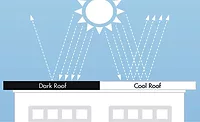ERA Recommends Updated Approach to Mitigate Urban Heat Island Impact

WASHINGTON, D.C. — The EPDM Roofing Association (ERA) is recommending that federal, state and local governments, as well as regulatory bodies, pause the development and implementation of reflective roofing and cool roofing mandates.
This recommendation from ERA is based on the findings of two studies funded by the association, which attempted to measure the efficacy of reflective or “cool” roofing as a mitigation strategy against the Urban Heat Island effect (UHI). These studies showed that complex and inconsistent temperature assessment protocols are being utilized in virtually all UHI evaluations, making comparisons of efficacy problematic.
“We need to develop a consistent way to measure the impact of reflective roofs, so that we can evaluate their efficacy compared to other mitigation strategies that are being used to lessen extreme heat in urban areas,” said Ellen Thorp, executive director of ERA. “Prudent building science requires us to call upon the federal and state governments to conduct additional research to assess the real-world relative value of all proposed solutions that might diminish the impact of the challenge of UHI."
For the initial study, ERA contracted with ICF, an independent consulting firm with experience in climate change, data analysis, and building science. ICF undertook an analysis of existing data and previous studies on UHI, with specific focus on the measurable impacts of the roof albedo of low-slope roofing. ICF's analysis of temperature data for cities with cool roof mandates found no discernable correlation between the imposition of cool roof mandates and a reduction in UHI.
“This does not necessarily mean that there is no correlation between cool roofs and the reduction of UHI,” said Jason Wilen, a forensic architect with Klein & Hoffman and technical consultant with ERA. “But it points to the need to develop a consistent way to measure the impact of reflective roofing, as well as other mitigation strategies.”
To further inform the findings of this initial study, ERA commissioned a companion literature review, working with the Department of Construction Science and Management at Clemson University. This literature review conducted a thorough investigation of published studies and models designed to understand the impact of membrane color on energy efficiency.
The macro-level literature review investigated more than 2,000 published articles, winnowing down the published literature to 280 references deemed appropriate for more intense review. According to the Clemson researchers, this exhaustive literature review exposed the reasons that there is no clear answer about the relationship of UHI and energy efficiency. The results of these studies varied because the impact of cool roofs is influenced by a range of factors such as roof type, climate, and location.
“In many instances, more recent studies based their conclusions and recommendations on widely distributed prior studies, which now must be considered dated or incomplete information given more updated research," said Dr. Dhaval Gajjar, a primary researcher on the project.
The studies also varied in methods of data capture and analysis, reliance on simulation-based studies and minimal data capture duration. Other factors potentially influencing varying outcomes included consideration of a “heat penalty” during the winter season and the interaction of different building heights. Additionally, there was no consistent comparison of the impact of urban tree canopy, roofs, hardscape, asphalt surfaces, and insulation thickness.
“Both of the ERA studies exposed inconsistencies in measuring the impact of reflective roofing on the severity of UHI, as well as on the amount of energy being used,” said Wilen. “Our focus, as we consider policies that are designed to lead us to a future where the UHI effect can managed and even diminished, must be based on science, not supposition.”
For more information, contact Louisa Hart, louisaghart@gmail.com and Ellen Thorp, ellen.thorp@epdmroofs.org or go to epdmroofs.org.
Looking for a reprint of this article?
From high-res PDFs to custom plaques, order your copy today!








